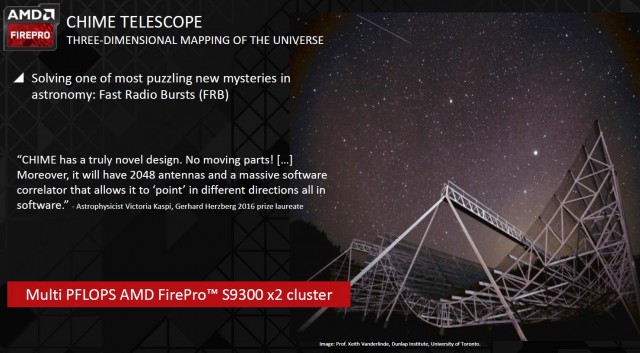
Earlier this month, AMD unveiled its first dual GPU based on its highest-end Fiji GPU. The Radeon Pro is clearly a niche card with a $1500 price and a specific focus on developing for VR — but AMD evidently has designs on more than one market. Today the company announced its FirePro S9300 x2 — the first and likely only Fiji-derived GPU the company will launch for the HPC space.
The S3200 x2’s consumer roots are visible in its specifications. Each GPU is limited to 4GB of memory in a market where 8GB RAM buffers are considered low-end and top-end cards can pack as much as 32GB of RAM. Unlike the Hawaii-based S9170, the S9300 x2 lacks support for ECC memory and its double-precision floating point performance is limited to 1/16 of FP32 (0.8 TFLOPS). The S9170, in contrast, offers up to 2.6TFLOPS of double-precision performance.

The S9300 X2’s primary strength is its single-precision floating point performance. At 13.9TFLOPS, it’s the most powerful single-precision card AMD has ever released and theoretically faster than anything in Nvidia’s current stable of hardware as well.

The S9300 x2 is designed for passive cooling and a 300W power envelope, which means clock speeds are substantially lower than what we typically see in a card of this type. AMD hasn’t revealed the expected clock speeds on the Radeon Pro Duo, but the GPUs it demoed at GDC had three eight-pin PCI Express power connectors. While companies typically overprovision their GPUs to ensure they can handle sharp transient spikes, the Radeon Pro Duo is clearly designed to pull more than 300W.
Then again, this matches what we saw with the Radeon Nano. Fiji’s power consumption rises sharply as its clock speed increases; keeping the GPU at a relatively low 850MHz ensures it can fit within its expected power envelope.
The HBM bottleneck
When AMD decided to use high bandwidth memory (HBM) for its Fiji GPU, it made a conscious tradeoff between memory capacity and raw bandwidth. The advantage of HBM is that it gives Fiji a 512GB/s memory bus in a much smaller footprint while using much less power. The disadvantage of first-generation HBM is that it’s limited to a 4GB memory buffer.

Ever since AMD announced Fiji, there’s been speculation that the company might use some kind of workaround to build a GPU with more than 4GB RAM. If such a technology was ever going to make an appearance, the S9300 x2 is where it would be deployed — the card’s $6000 price tag gives it room to bear the cost of development.
The flip side to this, however, is that the HPC field tends to be dominated by industry experts who are aware of the memory requirements of their own software. AMD has already announced it will provide an HPC cluster for processing data gathered by the Chime telescope, as shown above, and it also believes it can make inroads in the oil and gas business. These are all workloads where single-precision floating point performance is king, and the S9300 x2 should excel in these areas.
A niche product, but an important step
The S9300 x2 is a niche product even within the confines of the HPC space, but it’s still good to see AMD stepping up to the plate. One reason Nvidia has enjoyed much healthier margins compared to AMD is that it holds between 75-85% of the professional GPU market (the percentages shift somewhat depending on the quarter) and almost all of the HPC space. Of the Top 500 systems that use some type of co-processor, 66 use an Nvidia GPU, 29 rely on Xeon Phi, and just three use AMD Radeon.
Given that AMD GPUs now have the ability to run at least some CUDA code, thanks to the company’s Boltzmann initiative, the argument for using AMD may have just gotten stronger than it has ever been. Historically AMD’s high-end workstation and professional GPUs are cheaper than Nvidia’s (and yes, $6000 is cheap in this market). We’ll see if these changes yield fruit in the quarters to come.
Fonte: AMD announces new dual-GPU FirePro S9300 x2 designed for HPC and scientific computing | ExtremeTech

